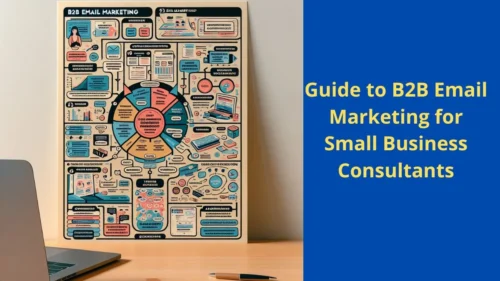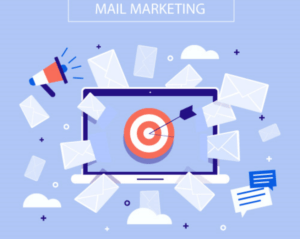In today’s dynamic business landscape, small businesses are constantly seeking cost-effective and efficient marketing solutions to reach their B2B clients. One powerful method that has proven to be highly effective is B2B Email Marketing. By harnessing the potential of targeted email campaigns, small businesses can directly engage with their B2B audience, drive conversions, and build long-lasting professional relationships. This article delves deep into the world of B2B Email Marketing Solutions for Small Businesses, exploring the best strategies, tools, and practices that can elevate marketing efforts to new heights.
Understanding B2B Email Marketing Solutions
If you’re running a small company and looking to get your name out there, diving into the world of email marketing might be the trick you need. Picture this: a marketing strategy that reaches directly into the inbox of other businesses, showing them exactly what you’ve got to offer. It’s not just about sending emails; it’s about sending the right message to the right people, and seeing your relationships—and sales grow as a result.
The Impact of B2B Email Marketing for Small Businesses
When we talk about the big game changers for small ventures, email marketing to other businesses stands tall as a giant. It’s like a secret superpower that doesn’t scream for attention, but boy does it pack a punch in the results department. For small companies trying to make a splash in the business-to-business pool, getting their message across through email is both thrifty and mighty effective.
Email isn’t just a way to send out a hello or a holiday card; it’s a strategy to generate leads, seal deals, and keep the conversation flowing. Imagine reaching out and grabbing your client’s attention amidst their cluttered inbox with something tailored just for them. Personalization and relevance are the names of the game here, making your small business stick out like a friendly thumb that’s there to help, not just sell.
Key Benefits of B2B Email Marketing Solutions
Email marketing is like having a direct line to your client’s desk. Imagine pinging them just at the right time with exactly what they need. That’s what proper email strategies can do for you. Not only is it cost-effective, but it also opens up a world of possibilities for enhanced engagement and tracking client interaction.
When you get your email marketing game on point, you’ll notice an increase in lead generation and sales. Emails let you talk directly to your buyer, making every message feel personal and considered. Plus, you can measure how effective your campaigns are. This makes it easy to tweak your approach for even better results, tailoring each step of your marketing to ensure maximum impact.
Crafting Effective B2B Email Campaigns
Creating emails that grab attention and get results is like putting together a puzzle. You need the right pieces – such as knowing your audience, crafting a message that resonates, and designing emails that are easy on the eyes. Put these pieces together, and you’ll have a campaign that not only reaches the inboxes of your business clients but also sparks their interest and action. Let’s dive into the strategies that can help your emails stand out and strengthen your business relationships.
Segmentation and Personalization Strategies
Getting your emails noticed is a bit like being the cool new kid at school—everyone’s curious, but they’ll only pay attention if you get them interested. That’s where segmentation and personalization come in. Imagine you’re at a bustling food market—shoppers are more likely to stop by your stand if you call out the fresh, spicy salsa they’ve been craving, rather than just shouting “sauce for sale!”
Segmentation is like sorting your contacts into different clubs based on what they like. You can group them by things they have in common, like the industry they’re in or how big their company is. This lets you tailor your messages, so they’re more relevant. Personalization takes it a step further. It’s about calling your customer by name, remembering their last purchase, or suggesting new stuff based on what they’ve bought before. It shows you’re paying attention to them as individuals, and not just sending out blanket emails. Using these strategies makes sure your email isn’t just another flyer in the wind but the invitation to the party everyone’s excited about.
Creating Compelling Content for a B2B Audience
Crafting content that resonates with other businesses isn’t just about selling a product or service; it’s about telling a story that aligns with their needs and goals. You want to be the answer to their problems, offering insights that can help them overcome challenges and thrive. To do this effectively, start by researching your audience thoroughly to understand their industry, language, and pain points. Then, curate your message to address these specific areas with solutions that your business can provide.
When you craft your emails, focus on the value—how your offering can save time, reduce costs, or boost efficiency. Remember to keep the tone professional yet engaging, making sure that every piece of content is valuable in its own right. The importance of clear, concise communication can’t be stressed enough; busy professionals appreciate content that gets to the point and helps them make informed decisions quickly.
Optimizing Email Design and Layout
A sleek and professional look is key when designing emails aimed at other businesses. First impressions matter, and your emails are a direct reflection of your brand. To make sure your emails stand out, focus on a clean design that directs your reader’s eyes to the most important parts of your message. Use headings, bullet points, and bold text to highlight key information or offers. This isn’t just about looking good; it’s about making your content easy to scan and digest.
Besides aesthetics, consider the practical side of things. Emails should be mobile-friendly, as many professionals check their inbox on-the-go. This means opting for a responsive design that adjusts to various screen sizes. Also, give thought to the email’s layout. Keep it simple with a single column structure for easy mobile viewing. Remember, when your emails are both pleasing to the eye and functional, you’re more likely to keep your audience engaged and ready to act on your message.
Leveraging Automation and Analytics
In the fast-paced world of business, staying ahead means embracing the tools that save you time and give you a deep dive into what’s working. Enter the dynamic duo of automation and analytics. These aren’t just buzzwords; they are game-changers for streamlining your email campaigns and understanding your audience. By automating repetitive tasks, you free up precious hours, while analytics allow you to peek into the universe of your campaign’s performance, fine-tuning your approach to perfection.
Streamlining Campaign Management with Automation Tools
When you dive into the email marketing pool, you’re juggling a lot—like crafting messages, scheduling sends, and tracking responses. Automation tools are like your trusty swim fins, helping you glide through the process effortlessly. These tools can schedule email blasts, segment your contacts, and even send follow-up emails based on user actions. This means you can set up a campaign and watch it run all by itself, saving you valuable time.
Imagine your business sending out a series of emails that feel personally tailored to each recipient, but without you lifting a finger for each one. With automation, you can make that a reality. Analytics are also part of the package, giving you a bird’s eye view of what’s working and what’s not. By embracing automation, your email campaigns can become more precise, more personal, and way more efficient. Plus, you free up time to focus on growing your business in other exciting ways.
Data-Driven Insights to Enhance Email Campaigns
Gone are the days when guesswork played a role in crafting email campaigns. Today’s savvy marketers rely on data-driven insights to sharpen their strategies and ensure their messages hit the mark. By studying the numbers, small businesses can uncover what resonates with their audiences, from the subject lines that get the most opens to the content that drives engagement.
Data tells a story about user behavior; it’s like having a roadmap to what your clients want and when they want it. By monitoring key metrics such as open rates, click-through rates, and conversion rates, businesses can make informed decisions that lead to more effective campaigns. Remember, the goal is not just to send emails, but to send emails that get Results!.
Nurturing and Growing B2B Relationships
In the dance of emails and deals, small companies have got to nail the steps of relationship-building. It’s not just about catching eyes with flashy subject lines or dazzling with slick templates; it’s about growing a garden of trust with every send button clicked. From the nurturing drips of communication to the way we tend to our leads, it’s the steady, thoughtful connections that turn seeds of interest into flourishing partnerships. Let’s explore this important piece of the email puzzle.
Building Trust Through Consistent Communication
Establishing a rapport with your business clients doesn’t happen overnight. It’s all about staying in touch and showing that your company is reliable and attentive. Think about it like watering a plant; regular emails can keep your relationship with clients fresh and growing. But, be careful not to turn into that one friend who messages too often, making the relationship feel more annoying than beneficial.
Consistency is key, but it’s not just about how often you email – it’s also about the quality of your communication. Keep your messages clear, relevant, and packed with value. Whether it’s sharing industry insights or just checking in, your emails should always make your clients feel respected and valued. That’s how long-term trust is built, setting the foundation for a partnership that can withstand the test of time and bring lasting benefits to your business.
Strategies for Lead Nurturing in B2B Email Marketing
Building and maintaining relationships with business clients isn’t a one-time event. It’s a journey. That’s where lead nurturing comes into play. It’s about regularly reaching out to potential clients with content that matters to them, guiding them down the path to becoming loyal customers.
Imagine each email you send out as a handshake, a friendly conversation where you provide valuable insights and solutions. Use personalized content to address their unique challenges and goals. This could be industry tips, case studies, or how-to guides that position your small business as a thought leader. And don’t forget to give it a personal touch – after all, businesses are run by people, and people love to feel understood and valued.
To sweeten the pot, weave in exclusive offers or early access to new products or services. This not only piques interest but also gives a sense of exclusive partnership. It’s smart to monitor interactions with your emails, using data to refine future conversations. And remember, patience and persistence are key. By consistently providing value, you’re sure to transform leads into long-standing business partners.
Choosing the Right B2B Email Marketing Tools
When it comes to reaching out and holding onto your business-to-business (B2B) customers, picking the best tools can really make a difference. Think of your marketing toolbox as a Swiss Army knife; you want the most effective gadgets to help you cut through the noise and get your messages to stand out. It’s all about finding software and platforms that not only fit your budget, but also sync seamlessly with your customer relationship management (CRM) and sales systems. Let’s explore what to look for in these tools to ensure your campaigns are as sharp and shiny as possible!
Top B2B Email Marketing Software and Platforms
When it comes to connecting with other businesses, choosing the right email marketing software can make all the difference. These platforms are designed to help you send emails that get noticed and drive action. They come with a ton of features like automation, analytics, and templates to make your life easier and your campaigns more effective.
A few favorites have risen to the top for their reliability and comprehensive toolsets. Mailchimp is a crowd favorite, with user-friendly designs and an all-in-one marketing platform, it’s perfect for small businesses just getting started. Then there’s HubSpot, which goes beyond email marketing, offering a full suite of sales and service tools wrapped around a powerful CRM. For those looking to dig deep into automation, ActiveCampaign provides advanced workflows that cater to your customers’ unique paths. Each of these platforms offers something special, so finding the right fit for your business is key to email campaign success.
Integration with CRM and Sales Systems
Connecting your email campaigns with Customer Relationship Management (CRM) and sales platforms can be a game-changer for small companies. It’s like having all your tools in one toolbox, so you don’t have to jump around different apps to get the job done. By integrating these systems, every email you send out can be tracked. This means you’ll know who’s interested in your products and follow up with them right away.
Small businesses can benefit big time from this setup. For instance, when a potential client shows interest in an email, the sales team gets the heads-up without delay. They can strike while the iron’s hot, starting a conversation that could lead to a deal. This seamless flow of information keeps everyone in the loop, making sure no opportunity slips through the cracks. Plus, keeping all client interactions in one place makes it easier to create a personal touch with every email you send.
Maximizing ROI with B2B Email Marketing
When it comes to B2B email outreach, return on investment, or ROI, is the name of the game. Every email sent should be a strategic move towards higher earnings and better business relationships. This is a battleground where understanding the metrics and fine-tuning your techniques for better conversion rates can yield incredible gains. But how do you transform your email efforts into measurable success? Let’s unlock the secrets to driving up your ROI and making every click count.
Understanding Email Metrics and Key Performance Indicators (KPIs)
Knowing if your email campaigns hit the mark is like having a secret compass that guides your ship in the vast ocean of marketing strategies. Email metrics and key performance indicators (KPIs) are that compass for businesses aiming to make the most of their email outreach. These tools aren’t just numbers; they’re insights into what’s working and what needs tweaking.
Mainly, there are a few numbers you should keep a close eye on:
- Open Rate: This tells you what percentage of recipients are actually opening your emails. It measures the initial appeal of your campaign—think of it as your email’s first impression.
- Click-Through Rate (CTR): Once your email is opened, the CTR indicates how many people clicked on a link within your email. It shows how engaging your content and offers are.
- Conversion Rate: The endgame of most campaigns is getting the recipient to take a desired action. The conversion rate lets you track how many clicks turned into actual sales or leads.
And let’s not forget Bounce Rate and Unsubscribe Rate, which point out potential issues with your email list health and content relevance, respectively.
By tracking these KPIs, you can fine-tune your strategies, ensuring that your message resonates with your audience—resulting in better engagement and a strong return on your email marketing investment.
Strategies for Conversion Optimization in B2B Email Marketing
Going the extra mile in your email campaigns means focusing on more than just sending out messages. It’s about ensuring that those emails drive results. Conversion Optimization is the secret sauce to getting the most out of your email efforts. This involves tweaking and fine-tuning various aspects of your emails to increase the chances of recipients taking the desired action, whether it’s signing up for a webinar, downloading a whitepaper, or making a purchase.
First up, pay attention to your subject lines; these are your first impressions. Keep them snappy, clear, and intriguing. You’ve got to spark enough interest to get that email opened. Inside, your call-to-action (CTA) should be loud and clear. Use action-oriented language and make it super easy for readers to know what you want them to do. A good CTA is like a signpost on a highway – it points you exactly where you need to go without distractions. Also, don’t forget to test different versions of your emails. Called A/B testing, this strategy lets you send out two variations of the same email to see which one performs better. Over time, this data goldmine will help refine your approach, turning those emails into conversion machines.
Conclusion
Navigating the B2B arena as a small business can be a challenge, but with the right approach to email outreach, it’s totally doable! By tapping into the art of sending targeted emails, using smart automation, and keeping a close eye on growth, small companies really have the chance to connect with other businesses in meaningful ways. Let’s zoom out and see the big picture: embracing email strategies as part of your business toolbox is not just smart; it’s a game-changer that can catapult a small business into the big leagues of success and sustainability.
Conclusion
As small businesses navigate the ever-changing B2B landscape, the power of B2B Email Marketing Solutions becomes increasingly evident. By understanding the nuances of crafting targeted email campaigns, leveraging automation, and optimizing for growth, small businesses can tap into a wealth of opportunities to connect with B2B clients and achieve remarkable results. Embracing these strategies and harnessing the full potential of B2B Email Marketing can propel small businesses toward sustainable growth and success in the competitive marketplace.


